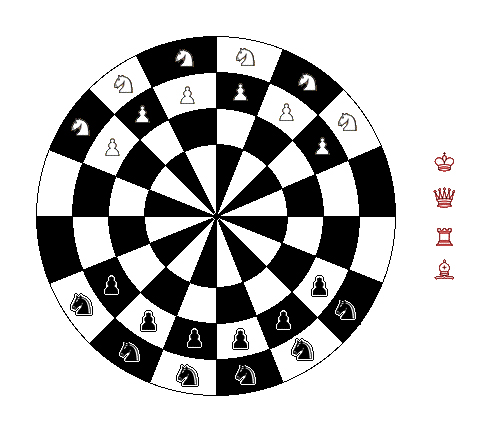Knights of the Round Table
Knights of the Round Table is a circular variant. It came from tinkering and experimenting with circular layouts.
Setup
 The board has 64 spaces consisting of three concentric rings of checkered spaces, and the central circular area is divided into 16 checkered pie wedges. The wedge checkers allow pieces to cross through the center of the board.
Two players set up their pieces on opposite sections of the board. Each player has six Knights and six Pawns. The Knights occupy the outermost ring, and the Pawns the next ring inwards.
The board has 64 spaces consisting of three concentric rings of checkered spaces, and the central circular area is divided into 16 checkered pie wedges. The wedge checkers allow pieces to cross through the center of the board.
Two players set up their pieces on opposite sections of the board. Each player has six Knights and six Pawns. The Knights occupy the outermost ring, and the Pawns the next ring inwards.
Pieces
When a Pawn or a Knight captures an opponent's Pawn or Knight, it must promote. Pawns promote to Knights (a set for this game should come with six extra Knights for each player). Knights promote to one of four red pieces. The piece (Pawn or Knight) being promoted is removed from the board, and the promoted piece is placed in any vacant space in the player's original starting row in the outermost ring. (This prevents a newly promoted piece from being captured and removed from the game right away.) Should there be no vacant space in the outermost row, it may be placed in the inner row. In the unlikely event there is no space in the inner row either, the player may place the promoted piece any place he or she wishes (assuming this scenario is even possible!). There is an order to the Knight promotions, regardless of which player acquires them: 1st promotion: Merlin (Bishop) 2nd promotion: Camelot (Rook) 3rd promotion: Guinevere (Queen) 4th promotion: Arthur (King) Once the red pieces are assigned to their players, their ownership does not change. Should one or more of these red pieces be captured BEFORE all four of them share the board at the same time, a Knight on its next capture may be promoted to the lowest-ranking available piece. When all four pieces are on the board at the same time, Knights no longer promote and the capture of a red piece removes it from the game permanently.
Rules
Directions for piece movements can be described as arc-wise (moving "sideways" along the rings), spoke-wise (towards or away from the center in a straight line) and diagonal (moving in one direction on only same-color spaces). In the central wedges, pieces can either move arc-wise or cross from one wedge to the one directly opposite. Wedges that are not directly opposite or are not directly adjacent arc-wise are not considered accessible by any piece. Pawns move one space arc-wise or spoke-wise (there is no "forward" distinction). They capture diagonally. When moving spoke-wise through the central wedges, Pawns cross from one wedge to the one directly opposite (the same color). Knights move/jump as in traditional Chess. When moving arc-wise through the central wedges, a Knight may move two spaces through the wedges and then cross over to the wedge directly opposite (opposite wedges will be the same color). The Bishop moves diagonally and may move in either parabolic paths or S-shaped paths by passing through the central wedges (crossing from one wedge to the one directly opposite). As there is only one Bishop in this variant, whatever color the player puts it on at the time of promotion is the color it will stay on the the duration of the game. The Rook moves arc-wise and spoke-wise any number of spaces. It crosses through the central wedges the same way as the Pawns do. The Queen moves any number of spaces in any direction, and can cross through the central wedges as the Bishop and the Rook do. The King moves one space at a time in any direction, and can cross through the central wedges as the Bishop and the Rook do (but only one space at a time). There is no castling, no initial double-step for Pawns and no taking en-passant. The goal of the player without the King is to put the King into Checkmate. The goal of the player who does have the King is to eliminate all the Knights of the King-less player.
Notes
Sometimes the play of the game will be uneven, as it is possible that one player will acquire the Rook, Bishop and Queen, while the other player only has the King. Since the King is vulnerable to Checkmate, this puts the King's player at a disadvantage. However, not every game will have this scenario.
 This 'user submitted' page is a collaboration between the posting user and the Chess Variant Pages. Registered contributors to the Chess Variant Pages have the ability to post their own works, subject to review and editing by the Chess Variant Pages Editorial Staff.
This 'user submitted' page is a collaboration between the posting user and the Chess Variant Pages. Registered contributors to the Chess Variant Pages have the ability to post their own works, subject to review and editing by the Chess Variant Pages Editorial Staff.
By Adam Goss.
Web page created: 2009-07-14. Web page last updated: 2009-07-14